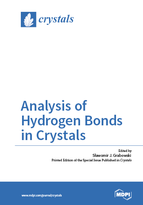Analysis of Hydrogen Bonds in Crystals
A special issue of Crystals (ISSN 2073-4352). This special issue belongs to the section "Crystal Engineering".
Deadline for manuscript submissions: closed (31 January 2016) | Viewed by 115252
Special Issue Editor
Interests: hydrogen bond; lewis acid–Lewis base interactions; atoms in molecules theory; ab initio calculations
Special Issues, Collections and Topics in MDPI journals
Special Issue Information
Dear Colleagues,
There is no doubt that the hydrogen bond is one of the most-often analyzed interactions, and there is also no doubt that experimental studies, especially those based on the determination of crystal structures are very important since they deliver valuable information on the nature of this interaction, on different types of the hydrogen bonds, and also on reactions where a hydrogen bond may be treated as the preliminary step.
Since the role of the analysis of crystal structures for investigations concerning hydrogen-bonded systems is valuable, the Editorial Board of Crystals, thus, decided to devote a Special Issue of the journal to the analysis of hydrogen bonds in crystals.
As Guest Editor I invite all Colleagues who work on hydrogen bonds in crystal structures to contribute to this issue. Topics relating to issues, such as comparison of different interactions (halogen, pnicogen, and others) with hydrogen bonding, as well as a comparison of crystal structure motifs with theoretical calculations, are welcome.
Prof. Dr. Sławomir J. Grabowski
Guest Editor
Manuscript Submission Information
Manuscripts should be submitted online at www.mdpi.com by registering and logging in to this website. Once you are registered, click here to go to the submission form. Manuscripts can be submitted until the deadline. All submissions that pass pre-check are peer-reviewed. Accepted papers will be published continuously in the journal (as soon as accepted) and will be listed together on the special issue website. Research articles, review articles as well as short communications are invited. For planned papers, a title and short abstract (about 100 words) can be sent to the Editorial Office for announcement on this website.
Submitted manuscripts should not have been published previously, nor be under consideration for publication elsewhere (except conference proceedings papers). All manuscripts are thoroughly refereed through a single-blind peer-review process. A guide for authors and other relevant information for submission of manuscripts is available on the Instructions for Authors page. Crystals is an international peer-reviewed open access monthly journal published by MDPI.
Please visit the Instructions for Authors page before submitting a manuscript. The Article Processing Charge (APC) for publication in this open access journal is 2600 CHF (Swiss Francs). Submitted papers should be well formatted and use good English. Authors may use MDPI's English editing service prior to publication or during author revisions.
Keywords
- Hydrogen bond
- Crystal structure
- Crystal engineering
- Hydrogen bond motifs in crystal structures






